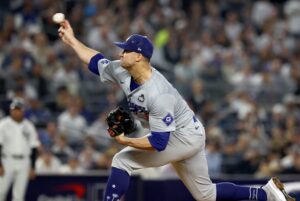Five Relief Units to Watch in 2020
With a 60-game schedule on tap, it’s fair to assume that bullpens are going to be utterly important this season. Maybe more so than ever because every manager is going to be looking for ways to extract as many wins as possible over a 60-game sample.
Furthermore, bullpens are going to play a significant role this season because there is so much unknown about certain teams starting rotations. Given the unusual nature of this year and Spring Training, some starting pitchers might simply not be ready to pitch at their normal level. That could especially be true at the beginning of the season.
As you look around baseball, there are certainly plenty of intriguing teams. The bigger challenge comes when you try to identify the five most intriguing bullpens. There might be intrigue based around the depth a particular team has. Another intrigue could come from the group a team might have locking down the back end.
Regardless, there are bound to be plenty of storylines this season about bullpens. Here are five bullpens to keep an eye on for potentially the most exciting storylines.
1. San Diego Padres
The San Diego Padres might have the best bullpen in all of baseball. At least that is the case on paper and only time will tell if that’s truly the case. San Diego added to it’s relief corp this past offseason with the signing of left-hander Drew Pomeranz to a four-year, $34 million dollar contract. It might have been an overpay, but Padres General Manager A.J. Preller knows now is the time for San Diego to take the next step forward and start winning. If you recall, Pomeranz concluded last regular season with the Milwaukee Brewers in grand fashion. After being traded from the San Francisco Giants, the 31-year old posted a 2.39 ERA over 25 games with an otherworldly 15.4 K/9 rate.
Another intriguing arm for San Diego is Emilio Pagan. The team acquired Pagan this last offseason in a trade with the Tampa Bay Rays. Last season, Pagan’s primary weapon was his cutter which he threw 36.6% of the time. Pagan was able to hold opponents to a .190 Batting Average Against (BAA) with that pitch and it had a cumulative whiff rate of 34.0%.
Besides Pomeranz and Pagan, another intriguing arm for San Diego is their latest acquisition in left-hander Tim Hill. San Diego acquired Hill in a trade this past week from the Kansas City Royals. Hill is going to be especially useful for San Diego against left-handed hitters on other National League West teams – most notably on the Los Angeles Dodgers. Last year, he held left-handers to a .186/.262/.203 batting line and a .229 Batting Average on Balls In Play (BABIP).
When you mix the aforementioned additions with the likes of Kirby Yates, Craig Stammen, Matt Strahm, and Luis Perdomo, you have a very intriguing bullpen. The 2020 season might be the year where a bullpen like that stands out from the rest of the crowd.
2. Tampa Bay Rays
Every season, the Tampa Bay Rays always find a way to patch things together with a small-market budget. This year, that is no exception and with how the Rays handle their pitching staff, the bullpen is always an area of intrigue. Remember, the Rays are the organization that originally came up with the concept of “The Opener.” Essentially, the team would name one of its relievers as it’s starting pitcher for the day and then have them pitch the first inning or two of a game before turning the baseball over to the rest of the bullpen.
Depending on the health of Tampa Bay’s starting rotation, that is a concept that could be in play once again. One of the more intriguing arms for the Rays is left-hander Jose Alvarado. Alvarado was a heavy sinker ball type of reliever last season. Overall, he threw that pitch 78.5% of the time which was the third most in all of baseball. Although Alvarado ended last season with a hastily 4.80 ERA over 35 games, he did make one start and had a cumulative strikeout percentage of 26.7%.
Outside of Alvarado, another intriguing arm among the Rays relief group is Nick Anderson. Anderson was acquired mid-season last year in a trade with the Miami Marlins. Over 23 games with the Rays, he posted a 2.11 ERA with a very impressive 17.3 K/9 rate. His true specialty is during situations with runners in scoring position. Last year during those situations, Anderson held opposing hitters to a .145/.221/.261 slash line.
The biggest intrigue about the Rays bullpen is that there are no set roles. When you mix Alvarado and Anderson with the likes of Diego Castillo, Colin Poche, Jalen Beeks, and Oliver Drake, it makes for one super strong unit.
3. Cincinnati Reds
After having quite an offseason, the Cincinnati Reds have the makings of a legitimate National League Central contender. Part of what makes the Reds such a strong team is the relief corp the team has built up especially at the back end. While the Reds didn’t necessarily make any splashy additions to their pen, they did add depth with the signing of Pedro Strop on a very affordable one-year, $1.85 million dollar contract. Additionally, Cincinnati brought in former Chicago White Sox reliever Nate Jones. Jones is a non-roster invite but has a chance to make the Opening Day roster.
The biggest intrigue for the Reds bullpen lies at the back end. Raisel Iglesias is slated to be the team’s closer and is a powerful arm to have in that role. Last season, Iglesias finished the year with a 4.16 ERA over 67.0 innings of work, but did record 34 saves and did very well his slider. Utilizing the slider, Iglesias held opposing hitters to a .197 BAA and a .223 Weighted On-Base Average (wOBA).
Further up on the depth chart for Cincinnati and the guy that will get the bulk of his work in the eighth inning is left-hander Amir Garrett. Garrett is yet another guy that relies heavily on the slider which he threw 58% of the time last season with lots of movement inside and outside the strike zone. Since debuting in 2017, Garrett has been a mixed bag with an overall career ERA of 5.12. Although, last year was a step forward and 2020 could be another successful season for him.
Along with Iglesias and Garrett, Cincinnati also has two-way player Michael Lorenzen in the mix. Anytime you have a two-way player among your relief corp, you instantly become intriguing. Other intriguing names include Lucas Sims and his curveball which has a spin rate of 3,120 RPM along with Robert Stephenson and his split-finger changeup.
4. Milwaukee Brewers
If there was one team in baseball that might use the 60-game schedule to their advantage, it would be the Milwaukee Brewers. After all, Milwaukee always seemingly is flying under-the-radar with low expectations in the National League Central. Craig Counsell and the entire coaching staff continually go out there and grind every day in an attempt to get better. The 2020 season will be no different for the Brewers and without a clear cut, workhorse at the top of the starting rotation, the bullpen will be extremely important for Milwaukee.
If you recall, it was only two years ago that closer Josh Hader really made his presence known to the rest of baseball. So far over a three-year career, Hader has combined for a 2.42 ERA over 204 and 2/3 innings of work. Last season alone, the left-hander recorded 138 strikeouts and averaged a career-low 15.61 pitches-per-inning over 61 games. While there were periods where he struggled, the skillset of Hader is still very high meaning there’s plenty of intrigue.
In addition, right-hander Corey Knebel provides plenty of intrigue for Milwaukee as well. After missing all of last season recovering from Tommy John surgery, Knebel could very well bounce back in a big way at 28-years old. Remember back in 2017 when he was coined the nickname “Evil Knebel?” Well, that might be something diehard and casual baseball fans start hearing once again this year.
When you figure in hybrid pitchers such as Brent Suter and Freddy Peralta as well as young, high upside guys like Corbin Burnes and Jake Faria, Milwaukee’s bullpen becomes very interesting.
5. Miami Marlins
Look, the 2020 season is likely to be another rebuilding year for the Miami Marlins. That doesn’t mean that there aren’t areas of intrigue surrounding the team though. Miami has come a long way over the past few years in identifying their core group of the future. As part of that process, the team has built up quite an interesting group of relievers. With expectations so low for the Marlins, it wouldn’t be a surprise to see some of these guys have a big season overall.
Easily the most intriguing relief arm for Miami is 29-year old Yimi Garcia. Garcia signed with the organization as a free agent last December. He has the ability to throw a five-pitch mix including a nasty curveball. Garcia’s curveball sits in the mid-80s but had a spin rate of 2,801 RPM last year. Combine that with a four-seam fastball that held opposing hitters to a .160 BAA and the intrigue for him elevates.
Besides Garcia, there’s a lot to like regarding right-hander Ryne Stanek as well. Stanek was a part of the aforementioned trade involving Nick Anderson. Last season, Stanek threw his split-finger 20.7% of the time. With that pitch, he held opposing hitters to a .141 slugging percentage and accumulated a 57.3% Whiff Rate with it. Considering that he is 28-years old, there still is a high potential that Stanek will continue getting better.
When you mix in the aforementioned Garcia and Stanek with the likes of Drew Steckenrider, Adam Conley, and Sterling Sharp, the Marlins have a fascinating group of high upside relievers.
Final Thoughts
At the end of the day, no one knows quite what to expect this coming season. After all, these projections are all based on past track records and numbers on paper. In addition, considering the volatility of relievers in today’s game, it’s possible that the bullpens listed here fall short of expectation. If everything goes according to plan though and the names mentioned above perform like they are capable of, then there is plenty of intrigue for those five teams relief units.
Main Image
Embed from Getty Images






